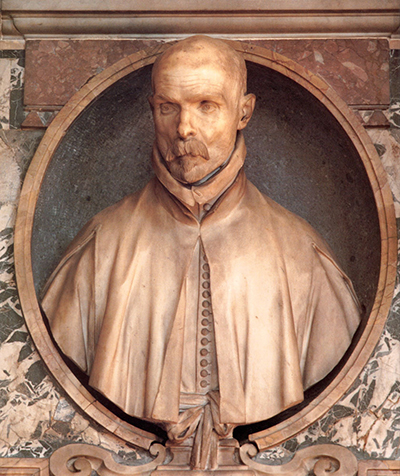The Bust of Monsignor Pedro de Foix Montoya (a Spanish monsignor) is a life-sized marble sculpture made, during 1621 and 1622, by one of the most famous artists of the Italian Baroque period, Gian Lorenzo Bernini.
It is a relatively early work (before the artist's most celebrated work funded by Urban VIII between 1623-44 as part of the Vatican's counter Reformation) and may possibly be the first commission that Bernini received from an important Spanish clergyman. At that point in his life Bernini made busts in order to improve his income and the complicated political relationships between Spain and Rome in this period meant that Bernini received a number of commissions from Spanish patrons including this one from Montoya.
The bust is in a tomb Montoya had made for him and was, up to the nineteenth century, in the church of San Giacomo degli Spagnuoli (at the time a Spanish possession in Rome). When Spain now longer owned that church the bust was moved to the refectory which adjoins the church of Santa Maria di Monserrato. Bernini was initially influenced by his father, also a sculptor, who taught him how to make his works realistic. This can be seen in the 1618-19 work, Aneas and Anchises, a sculpture that looks realistic from whatever angle the viewer chooses.
However, in the Montoya bust, Bernini chooses to restrict the viewpoint of the spectator to a single view. This increases the theatrical impact of the sculpture. The artist has tilted the head of the subject and made the sash he wears hang over the cartouche's edge. This, together with the fact that half the torso is visible, enables Bernini to suggest that the rest of the figure lies inside the niche.
Unlike his very exuberant later works this bust is still very realistic in many ways such as in the detail of the facial features including the remarkable bristles on the figure's moustache. In fact, Barberini is supposed to have said that he found the bust more lifelike than the subject. Bernini achieved this by his exceptional skill in working marble as well as by creating the bust from life. Later Bernini abandoned the Renaissance value of decorum becoming the most theatrical of the Baroque artists overwhelming the faithful who came to St. Peters.
Bernini was also a painter and an architect although he saw his architecture primarily as a setting for his sculptures. In this case, possibly because the work belongs to an earlier period, the architect of the tomb in which this bust sits was not himself but Orazio Turriani. The famous architect, Burromini, was influenced by Bernini having been an architectural apprentice of his in both St. Peters and the Barbarini Palace. Christopher Wren knew their work well and his idea of a dome for St. Paul's probably came from them. Images of Bernini's work are still extremely popular and their theatricality remains popular with tourists.




